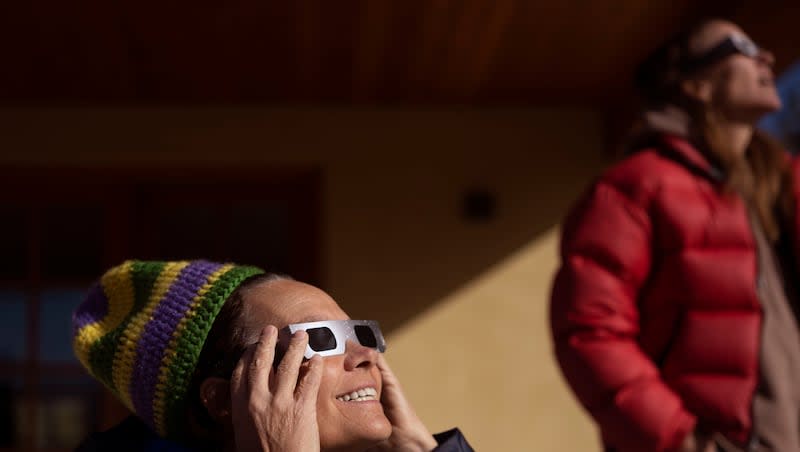Eclipse-onomics: April 8 event expected to drive over $1 billion in spending

The April 8 solar eclipse is expected to lure some 4 million people to the dozen-plus U.S. states that lie in the path of totality for the celestial event.
And that cavalcade of umbraphiles is expected to pump hundreds of millions of dollars into the lucky communities that are best located for the roughly four-minute view of a total eclipse in the middle of an event that will take about two hours from start to finish.
The optimum viewing corridor follows an arcing path that begins in south Texas and ends its journey across the continental U.S. in northern Maine. Businesses of all types are looking for ways to leverage an opportunity that, while it has presented itself twice in the last seven years thanks to the last total solar eclipse viewable in the contiguous states in 2017, will not be seen again until August 2044.
Hotels, resorts, cruise operators and airline companies have all found innovative ways to capitalize on the event, and for those who haven’t already booked or reserved, you could be out of luck.
“This is likely going to be the single biggest tourism event we’ve ever had,” Michael Pakko, an economist at the University of Arkansas at Little Rock, who is projecting a statewide windfall of $105 million, told the Washington Post. “Obviously, it’s going to be a short duration — a long weekend — but for that concentrated period of time, it’s going to be a very big deal.”
Everything’s bigger in Texas
Texas has the biggest single metro area in the path of totality, Dallas-Fort Worth, as well as Austin and San Antonio that, combined, account for 13 million residents who won’t have to go anywhere to view the event. Bulent Temel, assistant professor of practice and economics at the University of Texas at San Antonio, told the Texas Standard that a million or more eclipse watchers could be traveling to the state for the event and, the time the path of totality takes to travel through the state, will make it the most profitable event to ever happen in the state.
“Well, this spectacle is going to take a total of 22 minutes in the state of Texas,” Temel said. “And it’s going to bring somewhere between $150 million and $603 million, in our estimates, to the state economy. So that is likely to be the most profitable per minute stimulation of the state economy in the state’s 179-year history.”
Even tiny communities in the pathway are expecting eclipse windfalls next month.
Johnson County, Indiana, located just south of Indianapolis and boasting a population of about 165,000 residents is hosting a handful of eclipse-focused events and expects to see 100,000 or more visitors for the event. Ken Kosky, executive director of Festival Country Indiana, the tourism bureau of Johnson County, told the Daily Journal he estimates the economic impact of eclipse tourism and related spending could pump more than $10 million into the local economy and potentially as much as $25 million depending on the weather and other factors.
Delta Air Lines is flying two special eclipse flights, one each out of Austin and Dallas-Fort Worth, that feature planes with extra-large windows that will allow maximum viewing on trips that will spend extended time in the path of totality on the way to Detroit. While Delta initially only intended to fly one eclipse special from Austin, the company added a second flight on an even larger plane after the first one sold out in less than 24 hours.
Holland America is operating a 22-day Solar Eclipse Cruise, the Six Flags Over Texas amusement park is hosting a “Solar Coaster” and a Vermont ski resort, Jay Peak, has been sold out since last spring, according to the Post. Some 8,000 are taking part in the resort’s eclipse celebrations, which will include a Pink Floyd cover band playing “Dark Side of the Moon” as the eclipse begins.
Economists told Forbes total economic activity related to the April 8 eclipse viewing activities could easily surpass $1 billion with Ohio, Texas and Indiana set to see the most benefits.
How to safely view a solar eclipse
NASA scientists note safety is the top priority when viewing a total solar eclipse and encourage eclipse viewers to familiarize themselves with safety guidelines.
Some solar eclipse fun facts from NASA:
After the event on April 8, the next total solar eclipse visible from the contiguous United States will be on Aug. 23, 2044.
While earthlings typically aren’t able to see the sun’s outer atmosphere from their home planet, the corona becomes visible during a total solar eclipse and offers unique opportunities for study.
When the moon completely blocks the visible surface of the sun during a total solar eclipse, viewers can remove their eclipse glasses. NASA says a total solar eclipse is the only type of solar eclipse where the safety glasses can be momentarily removed.
At the point of totality, nocturnal wildlife sometimes wakes up, thinking it’s nighttime, according to NASA. And non-nocturnal wildlife may think it’s time to sleep.

